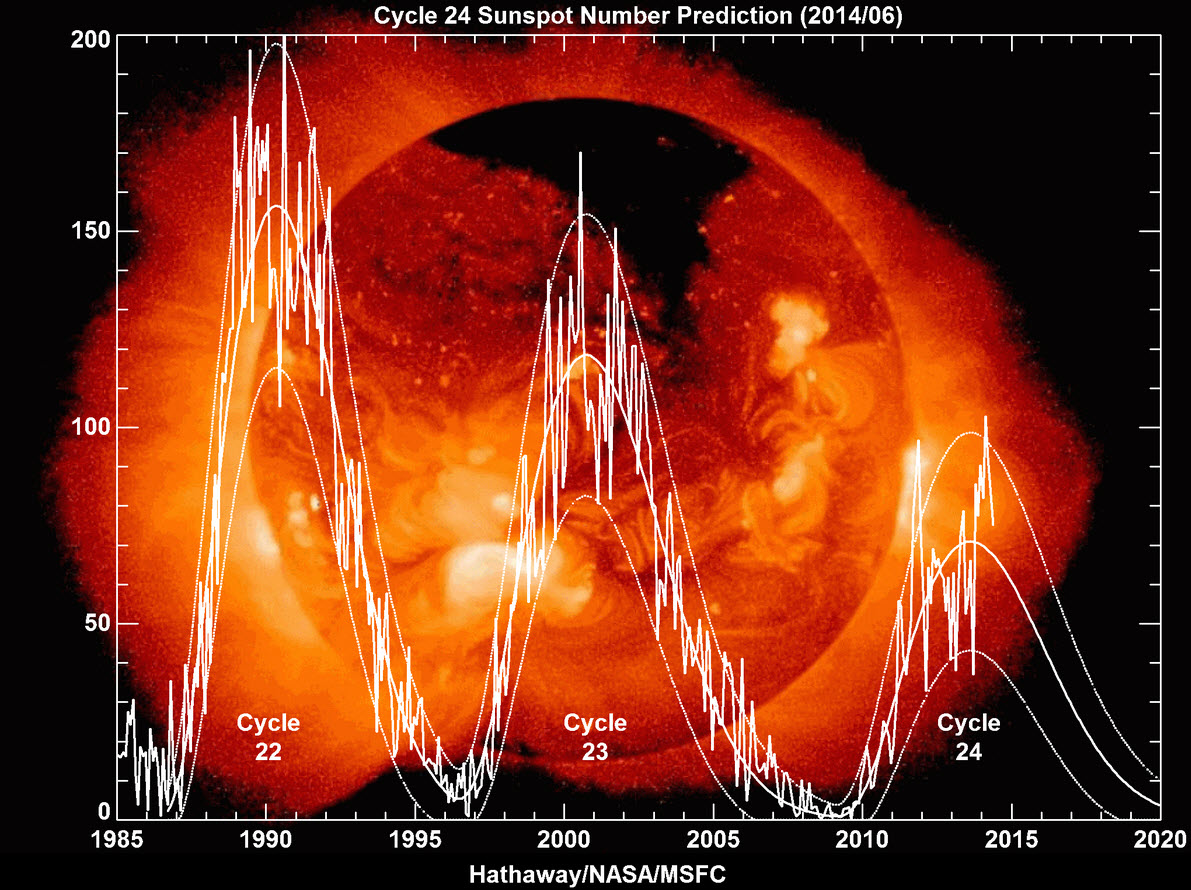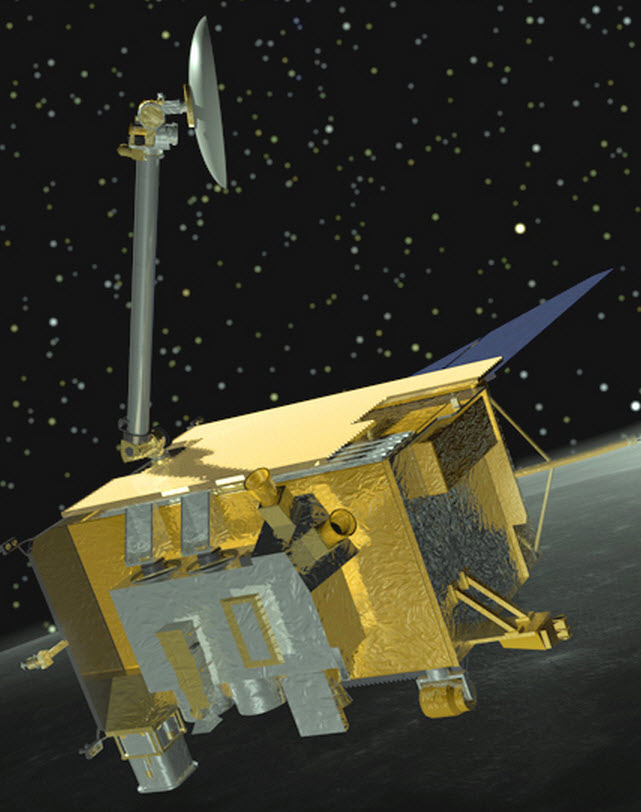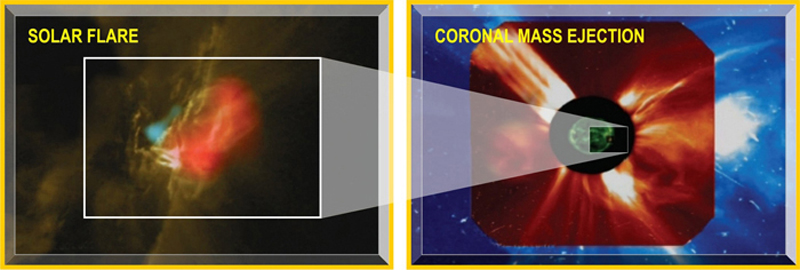Will cosmic rays threaten Mars One, other deep-space astronaut projects?
October 23, 2014

Predicted solar sunspots for Cycle 24, the smallest sunspot cycle since Cycle 14 in February 1906 (credit: David Hathaway/NASA Ames)
Crewed missions to Mars such as Mars One may face dangerous levels of cosmic rays (energetic particles), according to a new paper in the journal Space Weather by University of New Hampshire (UNH) scientists.
This is due to a recent highly abnormal and extended lack of solar activity, resulting in extremely low densities and magnetic field strengths in the solar wind.
This results in a serious reduction in the ability of the solar wind’s magnetic fields to block dangerous levels of hazardous cosmic rays, says associate professor Nathan Schwadron of the UNH Institute for the Study of Earth, Oceans, and Space (EOS) and the department of physics.

Artist’s rendition of the Lunar Reconnaissance Orbiter at the moon, showing the CRaTER telescope pointing out at the bottom right of the LRO spacecraft (credit: Chris Meaney/NASA)
“The behavior of the sun has recently changed and is now in a state not observed for almost 100 years,” says Schwadron, lead author of the paper and principal investigator for the Cosmic Ray Telescope for the Effects of Radiation (CRaTER) on NASA’s Lunar Reconnaissance Orbiter (LRO)*.
Highest intensities of galactic cosmic rays
He notes that throughout most of the space age, the sun’s activity has shown a clockwork 11-year solar cycle, with approximately six- to eight-year lulls in activity (solar minimum) followed by two- to three-year periods when the sun is more active. “However, starting in about 2006, we observed the longest solar minimum and weakest solar activity observed in the space age.”
These conditions brought about the highest intensities of galactic cosmic rays seen since the beginning of the space age, which have created worsening radiation hazards that potentially threaten future deep-space astronaut missions.
“Galactic cosmic ray radiation in particular remains a significant and worsening factor that limits mission durations,” says Schwadron.
The study is the capstone article in the Space Weather CRaTER Special Issue, which provides comprehensive findings on space-based radiation as measured by the CRaTER detector. The data provide critical information on the radiation hazards that will be faced by astronauts on extended missions to deep space such as those to Mars.
“These data are a fundamental reference for the radiation hazards in near Earth ‘geospace’ out to Mars and other regions of our sun’s vast heliosphere,” says Schwadron.
New risks to astronauts

The Sun itself is also a source of high-energy particles, such as those generated by this solar flare observed by the Reuven Ramaty High Energy Solar Spectroscopic Imager and associated coronal mass ejection observed by the Solar and Heliospheric Observatory spacecraft. Solar energetic particles from these events can easily penetrate typical shielding and damage spacecraft electronics and biological cells. (Credit: Nathan Schwadron, UNH-EOS)
CRaTER includes a material called “tissue equivalent plastic” — a stand-in for human muscle that is capable of gauging radiation dosage. Ionizing radiation from galactic cosmic rays and solar energetic particles remains a significant challenge to long-duration crewed missions to deep space. Human beings face a variety of consequences ranging from acute effects (radiation sickness) to long-term effects including cancer induction and damage to organs including the heart and brain.
The high radiation levels seen during the sun’s last minimum cycle limits the allowable days for typical astronauts behind spacecraft shielding. Given the trend of reducing solar output, the allowable days in space for astronauts is dropping and estimated to be 20 percent lower in the coming solar minimum cycle as compared to the last minimum cycle.
* The CRaTER investigation is a collaboration with team members at UNH, the University of Tennessee at Knoxville, Southwest Research Institute, Harvard-Smithsonian Center for Astrophysics, The Aerospace Corporation, the University of Michigan, and NASA Goddard Spaceflight Center.
Support for this research comes from NASA’s LRO/CRaTER mission, and NASA’S Earth-Moon-Mars Radiation Environment Module and Corona-Solar Wind Energetic Particle Acceleration projects. Additional support is provided by the National Science Foundation’s Frontiers in Earth-System Dynamics program, which funds the UNH-led “Sun-to-Ice” project that uses theory and modeling results to inform the analysis of current space-based NASA measurements of the radiation environment.
The NASA Goddard Space Flight Center in Greenbelt, Md. developed and manages the LRO mission. LRO’s current science mission is implemented for NASA’s Science Mission Directorate. NASA’s Exploration Systems Mission Directorate sponsored LRO’s initial one-year exploration mission that concluded in September 2010.
Abstract of Does the worsening galactic cosmic radiation environment observed by CRaTER preclude future manned deep-space exploration?
The Sun and its solar wind are currently exhibiting extremely low densities and magnetic field strengths, representing states that have never been observed during the space age. The highly abnormal solar activity between cycles 23 and 24 has caused the longest solar minimum in over 80 years and continues into the unusually small solar maximum of cycle 24. As a result of the remarkably weak solar activity, we have also observed the highest fluxes of galactic cosmic rays in the space age, and relatively small solar energetic particle events. We use observations from the Cosmic Ray Telescope for the Effects of Radiation (CRaTER) on the Lunar Reconnaissance Orbiter (LRO) to examine the implications of these highly unusual solar conditions for human space exploration. We show that while these conditions are not a show-stopper for long duration missions (e.g., to the Moon, an asteroid, or Mars), galactic cosmic ray radiation remains a significant and worsening factor that limits mission durations. While solar energetic particle events in cycle 24 present some hazard, the accumulated doses for astronauts behind 10 g/cm2 shielding are well below current dose limits. Galactic cosmic radiation presents a more significant challenge: the time to 3% Risk of Exposure Induced Death (REID) in interplanetary space was less than 400 days for a 30 year old male and less than 300 days for a 30 year old female in the last cycle 23–24 minimum. The time to 3% REID is estimated to be ~20% lower in the coming cycle 24–25 minimum. If the heliospheric magnetic field continues to weaken over time, as is likely, then allowable mission durations will decrease correspondingly. Thus, we estimate exposures in extreme solar minimum conditions and the corresponding effects on allowable durations.